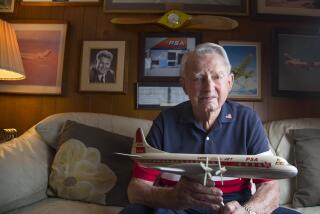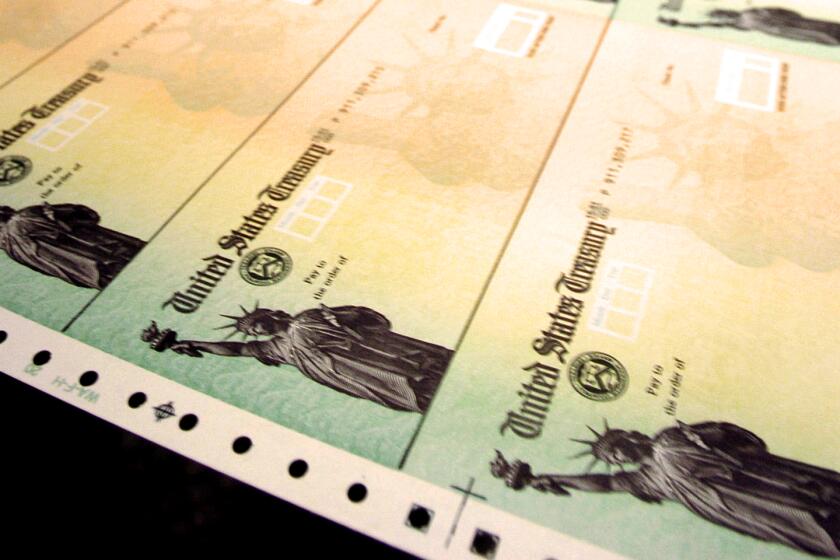Last Plane Out for Aerospace Pioneer
- Share via
Almost to the day Donald W. Douglas flew his first plane 80 years ago, the last aircraft to carry his name will be rolled out in Long Beach, ending another chapter of Southern California’s aviation history.
At an elaborate ceremony today at the plant’s main hangar, former McDonnell Douglas Corp. executives, engineers and factory workers will be watching as an MD-11, the last commercial aircraft built under the company name, is delivered to Lufthansa.
“It’s the end of a historic era,” said John C. Brizendine, former McDonnell Douglas president who retired in 1982 after 34 years at the company, which was acquired by Boeing Co. in 1997. “It will be a sad event.”
For Southern California, the delivery of the 200th MD-11, a wide-body with three jet engines, represents another retrenchment of its commercial aircraft industry, which once had massive factories in cities from Burbank to Long Beach to San Diego.
Commercial aircraft manufacturing has dwindled to a single Boeing facility in Long Beach, where about 5,000 workers make the 106-passenger 717 jet that was derived from the original MD-95. In its heyday, the massive Long Beach complex had more than 160,000 workers, producing three or four types of airplanes simultaneously.
“It’s not only the end of an era, it symbolizes the decline of the aerospace industry [in Southern California],” said Jack Kyser, chief economist for the Los Angeles County Economic Development Corp. The number of aerospace jobs--most of which provide middle-income salaries--fell from 274,000 in 1988 to 116,800 last year, he said.
Having the MD-11 as the last carrier of the McDonnell Douglas name provides a twist to what many aviation historians believe was the cause of its demise. The aircraft is a modified version of the DC-10, which during the 1970s was involved in one of the industry’s hottest battles with the rival L-1011, which built by what is now Lockheed Martin Corp.
“It is the last of the McDonnell Douglas legacies, but it wasn’t the company’s greatest moment either,” said Richard L. Aboulafia, director of aviation consulting for Teal Group Corp., a Fairfax, Va.-based research firm.
The celebrated competition between the wide-body aircraft left McDonnell Douglas tattered financially and prompted Lockheed to get out of the commercial aircraft business altogether. McDonnell Douglas was eventually forced to look for a suitor when it suffered a second major blow by losing the contract in 1996 to develop the Joint Strike Fighter, the next-generation military aircraft.
“It was a destructive competition, and neither company ever fully recovered from its effects,” wrote John Newhouse in “The Sporty Game,” his book about high-stakes competition in the commercial aircraft industry.
Brizendine, who isn’t sure he’ll attend today’s ceremony, said the two planes were too much alike. Except for the third engine that sits a little differently on the aft fuselage, the DC-10 and the L-1011 were virtually identical in length, width, wingspan and capacity, as well as range, speed, engine thrust and operating costs.
“They were two olives out of the same bottle,” Brizendine said. “The world didn’t need both of them. Both suffered as a result.”
The companies provided deep discounts to airlines to undercut each other, leaving little room for profits. And when the six major airlines split the orders between the two types, there wasn’t enough business for either company. Lockheed lost $2.5 billion before it canceled the L-1011 program.
Subsequent miscalculations and ill-advised decisions doomed the successor to the DC-10, the MD-11, Aboulafia said. Financially strapped, McDonnell Douglas rejected proposals to develop a new mid-range plane, which would have cost at least $2 billion, and instead opted to modify the DC-10.
But as development and production problems plagued the MD-11 and delayed its delivery, Boeing launched its own mid-range airplane, the 767, similar to what McDonnell Douglas engineers had proposed. The Boeing plane started flying just as airline deregulation created greater demand for planes that could fly point-to-point between hub airports.
Staggering out of the gate in 1990, the MD-11 faced another formidable competitor in Airbus Industrie, a European consortium. When Boeing moved ahead with the development of the 777, a wide-body, two-engine jet with modern design and avionics, the MD-11’s end was certain, analysts said. About half of the 199 MD-11’s in service have been modified for cargo service.
The delivery of the last MD-11 comes 80 years after Douglas flew his first plane on Feb. 23, 1921.
With only $600 in his pocket, the New York native had moved to Californiathe year before and started building his first plane, the Cloudster, in the back room of a barber shop on Pico Boulevard in Santa Monica.
In 1922, Douglas moved his operations to an abandoned movie studio on Wilshire Boulevard in Santa Monica, where he began building Douglas World Cruisers, two of which became the first planes to circle the world. With increasing demand and with World War II looming, Douglas opened a new aircraft assembly plant adjacent to Daugherty Field, now Long Beach Airport, in 1941.
During the war, the plant delivered more than 31,000 aircraft, including the C-47 SkyTrain, the SBD dive bomber, the C-54 transport, A-20 and A-26 attack bombers and B-17 bomber. In all, Douglas--which merged with McDonnell Aircraft, a St. Louis military aircraft maker, in 1967--produced more than 45,000 commercial and military airplanes.
Years later, Douglas was asked why he had chosen California to build his airplanes.
“California has long been a place where I wanted to live . . . because I felt that if there is to be any civilian aeronautics, it will be there that it will first attain real success,” he said.
(BEGIN TEXT OF INFOBOX / INFOGRAPHIC)
End of an Era
When the last MD-11 trijet is delivered to Lufthansa, it will mark the end of the legacy started by Donald W. Douglas 80 years ago. Since 1920, the company has built more than 45,000 commercial and military airplanes.
*
Deliveries of wide-body jets
McDonnell Douglas, now a part of Boeing, was a distant No. 2 competitor in the sale of wide-body aircraft. Sales of the DC-10 and its updated version, the MD-11, totaled just more than half the number of Boeing 747s sold year to date.
*
Boeing 747: 1,261
McDonnell Douglas DC-10: 446
McDonnell Douglas MD-11: 200
646 total
Lockheed Martin L-1011: 249
The Legacy of Donald W. Douglas
1920: Donald W. Douglas begins building first plane in the back room of a Pico Blvd. barbershop.
1933: DC-2 twin-engine passenger plane is built.
1936: DC-3, one of the more durable passenger planes, is built. Some still fly today.
1941: Douglas Aircraft builds assembly plant next to Daugherty Field, now Long Beach Airport.
1958: DC-8, a four-engine commercial jet, begins production.
1965: DC-9, a twinjet with aft-mounted engines, begins production.
1967: Douglas Aircraft Co. merges with McDonnell Co. to create McDonnell Douglas.
1968: DC-10, a wide-body trijet, begins production.
1979: DC-10 crashes in Chicago, killing 273 people, then nation’s worst crash.
1980: MD-80 series of twinjets begins production.
1990: MD-11, a wide-body trijet, begins production.
1995: MD-90, a twinjet, begins production.
1997: McDonnell Douglas merges with Boeing.
Feb. 22, 2001: Last MD-11 is delivered.
Source: Boeing Co.
*
More to Read
Inside the business of entertainment
The Wide Shot brings you news, analysis and insights on everything from streaming wars to production — and what it all means for the future.
You may occasionally receive promotional content from the Los Angeles Times.










